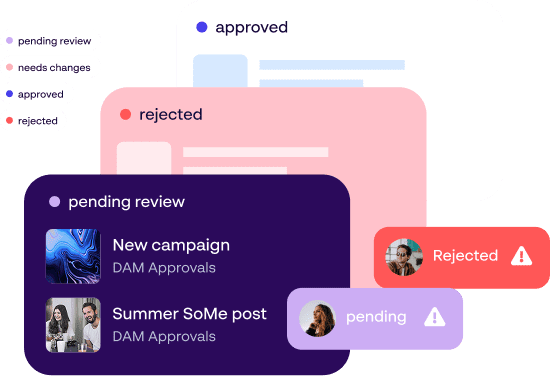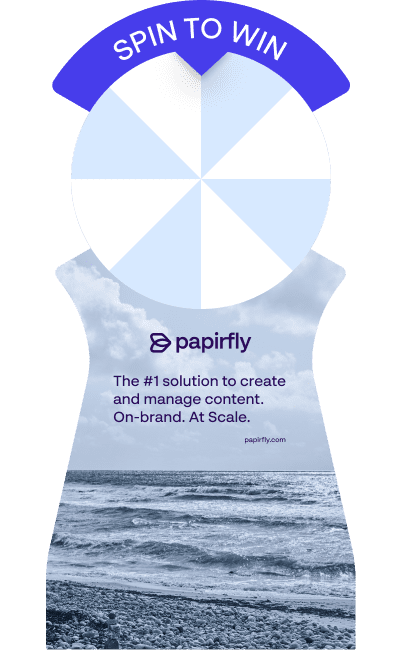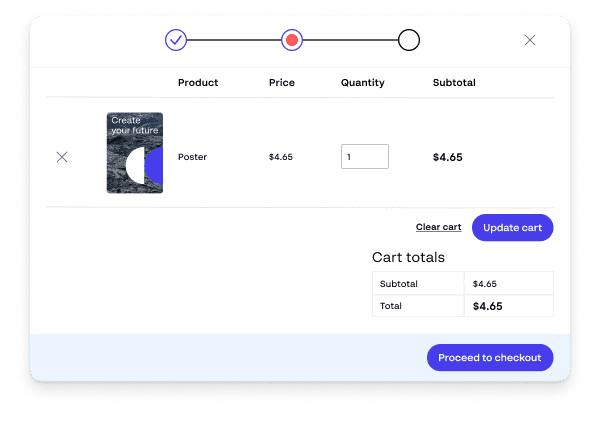This content has been automatically translated and may include minor variations.
Live events are back on the rise — and with them, the logistical challenges that B2B marketers know all too well. In today’s competitive landscape, a strong event marketing strategy hinges on seamless collateral management. From branded banners and tablecloths to promotional giveaways and social media visuals, event collateral plays a pivotal role in brand experience.
But with decentralized teams, tight timelines, and limited resources, the process of producing and managing these materials often spirals into chaos.
To make every event smoother, more impactful, and more scalable, you don’t need more tools — you need smarter systems. Here are five essential hacks to help you take control of your event collateral — so every rollout is fast, flawless, and fully on-brand.
1. Templates are your event marketing MVP
Event collateral demands variety — and the right content creation tools make it easy to scale across markets. You’ll likely need social tiles, flyers, banners, digital signage, merchandise tags, and more — and often each in several versions depending on the audience, location, or format.
Creating each version from scratch wastes valuable time and creates dependency on overbooked designers. Templated designs solve this by letting you build one branded layout that can be quickly adapted across markets, channels, and formats.
Using a content platform with templating capabilities allows teams to customize only what’s needed — like location names, dates, or languages — while design elements stay locked in place. This ensures every asset is brand-compliant, produced faster, and requires zero design experience on the user’s part.

2. Fast-track approvals to keep your event marketing strategy on track
Approvals are one of the biggest blockers in event execution. Even when assets are ready, delays in sign-off can stall production, miss print deadlines, or compromise event timelines. These delays are rarely intentional — they’re often the result of unclear processes or unaligned expectations.
Clarify who needs to approve each asset, brief them early, and build your timelines around that reality. A tech solution with built-in approval workflows can also help manage this complexity. Assign reviewers, set deadlines, and trigger automated notifications so that everyone knows what to expect and when. Having full visibility into the status of each task also prevents bottlenecks from going unnoticed until it’s too late.

3. Creative ideas don’t need to create more work
Memorable activations are what turn a standard booth into a standout experience. But creative ideas can be hard to scale — especially across multiple regions or events. What’s needed is a way to maintain the concept while adapting it for different markets, audiences, or objectives.
Using a flexible content platform that allows importing of custom designs (like from InDesign) into editable templates makes it easy to replicate successful ideas. Teams can localize visuals, update content, and get them printed through integrated partners — all without reinventing the wheel or compromising creative quality.

4. Local production beats global shipping every time
Shipping event collateral across borders adds layers of complexity to your event marketing efforts. Customs, shipping delays, minimum order quantities, and added costs all increase the risk of something arriving late — or not at all.
A solution that connects with a network of verified local print and production suppliers, especially one that can access your approved designs or templates, cuts out most of that risk and can help eliminate the pain of global logistics.
You maintain central oversight of materials and designs, while regional teams receive high-quality, on-brand assets produced and delivered locally — faster, cheaper, and with fewer risks.

5. Consolidate vendors to reclaim your time
From booth design and printed signage to giveaways and apparel, most events involve coordinating multiple suppliers. But managing separate orders, quotes, and communication threads for each one adds pressure — especially when you’re running several events at once.
Where possible, bring these processes into one place. Whether through a single point of contact or a centralized management platform, reducing the number of separate touchpoints can save hours — and minimize the chances of important details falling through the cracks. It also simplifies finance and procurement, making it easier to track spending, approvals, and post-event reporting.

Why event collateral matters across every market
Every uncoordinated process, unclear workflow, or duplicated task doesn’t just cause a momentary setback — it compounds over time and across events. When event collateral production is optimized, everything from timelines to team morale improves. You reduce costs, improve brand consistency, and free your teams to focus on what matters most: creating standout experiences.
Get these five areas right, and your events become not only more impactful — but more repeatable, scalable and sustainable across every region you operate in.
To hear more about this, catch our on-demand webinar where we discuss how to optimize event logistics with Christian Saetburg, CRO and co-founder of Ciloo — one of Papirfly’s partners specializing in simplifying global merch production.

Ready to simplify your event planning and scale with consistency?
Empower teams with smarter event collateral management. Find out more!
Table of contents:
- 1. Templates are your event marketing MVP
- 2. Fast-track approvals to keep your event marketing strategy on track
- 3. Creative ideas don’t need to create more work
- 4. Local production beats global shipping every time
- 5. Consolidate vendors to reclaim your time
- Why event collateral matters across every market


